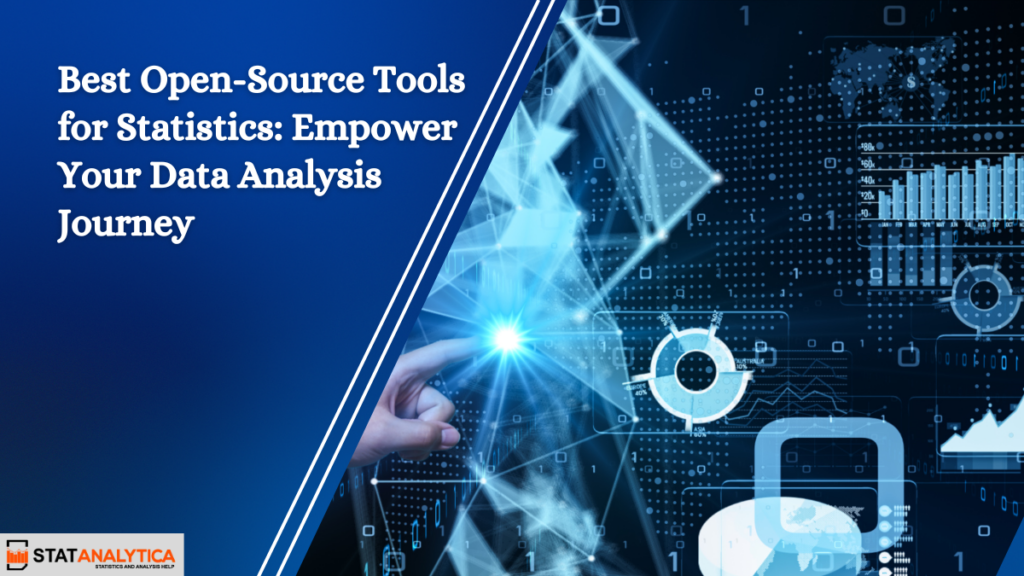In today’s data-driven world, statistical analysis plays a crucial role in decision-making across industries. Whether you’re a student, researcher, data analyst, or business professional, choosing the right tools for statistics can significantly improve the quality of your insights. Fortunately, the world of open-source statistical software offers incredible flexibility, performance, and cost savings.
In this blog, we’ll explore the best open-source tools for statistics that can help you perform anything from basic data summaries to advanced machine learning models. These tools are not just free—they’re powerful, flexible, and backed by active global communities.
Why Choose Open-Source Tools for Statistics?
Table of Contents
Many professionals and academic institutions prefer open-source tools due to their numerous advantages. First and foremost, they are completely free to use, making them highly accessible for students and small businesses. Moreover, they offer transparent and modifiable source code, which allows users to customize features according to their needs.
Another key benefit is the extensive community support available. From forums and GitHub repositories to user-created tutorials, help is always at hand. Whether you need software for data visualization, regression analysis, predictive modeling, or hypothesis testing, open-source tools offer everything a professional might need—without breaking the bank.
Popular keywords: free tools for statistical analysis, statistical programming tools, open-source statistics software for data analysis.
Top 10 Best Open-Source Tools for Statistics
Here is a list of the top-rated and most trusted open-source statistical tools used across industries and academic fields.
1. R Programming Language
One of the most powerful and widely used tools, R programming for statistical analysis, is a favorite among researchers and data scientists.
R is equipped with a huge repository of packages via CRAN (The Comprehensive R Archive Network), supporting everything from basic t-tests to complex Bayesian models. With powerful libraries like ggplot2, dplyr, and caret, R excels at both data manipulation and visualization.
Example: Use ggplot2 to create high-quality graphics for your reports.
RStudio, an open-source IDE for R, makes it even easier to write, debug, and document code—ideal for both beginners and professionals.
2. Python with Statistical Libraries
Python is a general-purpose programming language that has emerged as a major tool for data analytics. When equipped with libraries such as pandas, NumPy, SciPy, and statsmodels, Python becomes an outstanding open-source alternative for statistical computing.
The combination of Python with matplotlib and seaborn for data visualization, or scikit-learn for machine learning, makes it highly versatile.
Example: Use statsmodels to perform linear regression or ANOVA on experimental data.
Python’s readability and vast documentation make it beginner-friendly, especially for those entering the field of data science or AI.
3. JASP (Jeffreys’s Amazing Statistics Program)
If you’re new to statistics and want a graphical user interface, JASP is the perfect entry-level tool. Designed to simplify statistical analysis, JASP offers both classical and Bayesian analysis with a drag-and-drop interface.
This open-source software is particularly popular in social sciences and academia. Its outputs are well-formatted and easy to interpret, making it perfect for students, teachers, and researchers.
4. Jamovi
Built on the R language, Jamovi is a modern and intuitive open-source statistical software that aims to bring the power of R to a point-and-click interface.
With easy-to-navigate tabs and a responsive design, Jamovi is widely used in the fields of psychology, education, and health sciences. It supports t-tests, ANOVA, correlation analysis, and even regression modeling.
Ideal for those who want to avoid coding but still need reliable statistical results.
5. PSPP
If you’re familiar with SPSS but want a free alternative, PSPP is your go-to solution. It supports a wide range of statistical tests, including t-tests, ANOVA, chi-square tests, and regression analysis.
Since it’s syntax-compatible with SPSS, users can quickly transition without a steep learning curve. PSPP is lightweight, fast, and ideal for basic to intermediate statistical analysis.
Use case: Suitable for undergraduate students or research analysts working on survey data.
6. KNIME (Konstanz Information Miner)
KNIME is a robust open-source platform that allows users to design data workflows visually. Its intuitive drag-and-drop interface enables users to connect nodes for data manipulation, transformation, and statistical operations.
KNIME integrates with R, Python, and SQL, making it highly flexible. It’s used for everything from data cleaning and ETL (Extract, Transform, Load) to advanced analytics and machine learning.
7. Orange
Orange is a visual programming tool for data mining and statistical analysis. Its widget-based design makes it one of the most beginner-friendly platforms for exploring data.
With modules for classification, regression, clustering, and visualization, Orange is used in academic teaching, research, and prototyping machine learning models.
Great for visual learners and those who want interactive results.
8. SOFA Statistics
SOFA (Statistics Open For All) is another excellent tool that emphasizes usability. It can generate descriptive statistics, correlation matrices, and simple inferential tests like t-tests and ANOVA.
Its standout feature is the ability to connect to various databases like SQLite, MySQL, and MS Access, making it useful for data stored in external systems.
9. Weka
Weka is a Java-based open-source software primarily used for data mining and statistical modeling. It includes features for classification, regression, clustering, and visualization.
Weka’s GUI makes it ideal for those who prefer a point-and-click approach to statistical computing. It’s widely used in educational settings to teach machine learning and data analysis.
10. ROOT (By CERN)
Developed at CERN, ROOT is a powerful open-source framework tailored for high-energy physics and scientific computing. It’s built in C++ and is capable of handling large data volumes efficiently.
ROOT provides advanced tools for data modeling, visualization, and histogramming, and is often used in cutting-edge scientific research.
Comparison Table of Tools
| Tool | Ideal For | Coding Required | Key Strengths |
| R | Research, Academia | Yes | CRAN, RStudio, statistical depth |
| Python | Data Science, ML | Yes | Versatility, ML integration |
| JASP | Beginners, Social Science | No | GUI, Bayesian & classical analysis |
| Jamovi | Psychology, Education | No | R-based, easy to use |
| PSPP | SPSS Alternative | No | Lightweight, syntax-friendly |
| KNIME | Data Workflow Automation | No (optional) | Node-based, flexible integrations |
| Orange | Education, Visual Learning | No | Widget-based interface |
| SOFA Stats | Quick Stats, Reporting | No | Database connectivity, simplicity |
| Weka | Machine Learning Education | No | Easy ML, classification, GUI |
| ROOT | Scientific Research | Yes | Large-scale computation, physics |
Popular Use Cases of Open-Source Statistical Tools
Open-source tools are highly flexible and can be used in multiple domains:
- Education: Jamovi, JASP, PSPP are commonly used in university courses to teach statistics.
- Business Intelligence: KNIME and Python help in real-time analytics, dashboards, and forecasts.
- Medical Research: R and SOFA Statistics are used for analyzing clinical trial results and survey data.
- Scientific Discovery: ROOT is essential in analyzing data from particle physics experiments.
Popular keywords: open-source tools for data science, best data analysis software free, R vs Python for statistics.
Tips to Choose the Right Tool
Selecting the right open-source software depends on your experience level and project needs:
- For beginners: JASP or Jamovi
- For coders: R and Python
- For workflow automation: KNIME
- For quick visualizations: Orange
- For academic compatibility with SPSS: PSPP
Start small, experiment with datasets, and explore the tool that fits your goals best.
Final Thoughts
Exploring the best open-source tools for statistics opens a world of possibilities. Whether you’re performing simple descriptive statistics or building predictive models, there’s a free tool out there tailored to your needs.
By choosing open-source, you’re not only saving money but also gaining access to tools with strong support, active development, and unmatched flexibility. Begin your journey today with tools like R, Python, Jamovi, and KNIME, and unlock the true potential of your data.
Which open-source software is best for beginners?
Jamovi and JASP are highly recommended for those starting out in statistics due to their intuitive interfaces and quick learning curves.
Can these tools be used professionally?
Yes, many professionals use R, Python, KNIME, and PSPP for real-world business and academic applications.
Are open-source tools secure?
Absolutely. Open-source projects are regularly reviewed and updated by large communities, often making them even more secure than proprietary alternatives.


